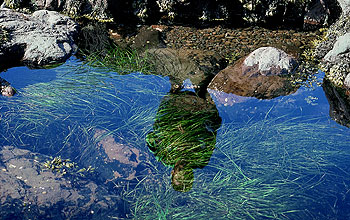Multimedia Gallery
Reflections in biodiversity
The Kuril and Sakhalin Island projects are international efforts to document the biodiversity of the landmasses that surround and enclose the Sea of Okhotsk. The primary centers of focus are the Kuril Islands, Sakhalin Island, the Okhotsk coast of Siberia and the Kamchatka Peninsula.
Funded primarily by the National Science Foundation's (NSF) Biotic Surveys and Inventories program, the research objectives are to record the detailed species-level diversity of life in aquatic and terrestrial habitats of the Okhotsk region, as a prologue to investigations of biological patterns and processes; and as a basis for the development of conservation strategies for this part of the world.
Each summer since 1994, three-dozen scientists and their students from the University of Washington, the Far East Branch of the Russian Academy of Sciences and Hokkaido University spend eight weeks aboard a Russian research vessel exploring remote islands and continental shorelines.
To learn more, visit the program's website Here.
This research was supported by NSF grants DEB 94-00821, DEB 95-05091 and DEB 00-71655; Theodore W. Pietsch, principal investigator.
Credit: Theodore W. Pietsch
Images and other media in the National Science Foundation Multimedia Gallery are available for use in print and electronic material by NSF employees, members of the media, university staff, teachers and the general public. All media in the gallery are intended for personal, educational and nonprofit/non-commercial use only.
Images credited to the National Science Foundation, a federal agency, are in the public domain. The images were created by employees of the United States Government as part of their official duties or prepared by contractors as "works for hire" for NSF. You may freely use NSF-credited images and, at your discretion, credit NSF with a "Courtesy: National Science Foundation" notation.
Additional information about general usage can be found in Conditions.
Also Available:
Download the high-resolution JPG version of the image. (3.1 MB)
Use your mouse to right-click (Mac users may need to Ctrl-click) the link above and choose the option that will save the file or target to your computer.

